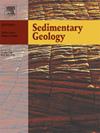Sequence architecture of a Miocene marginal shelf sea influenced by tectonic activity: A case study of Eastern Yinggehai Basin, South China Sea
IF 2.9
2区 地球科学
Q1 GEOLOGY
引用次数: 0
Abstract
While sequence stratigraphic frameworks of passive continental margins have been extensively studied, their counterparts in semi-enclosed marginal shelf seas remain poorly understood. This study investigates the sequence architecture and depositional patterns of a marginal shelf sea system through integrated analysis of 3D seismic, well-log, and core data from the Miocene succession in the Yinggehai Basin, South China Sea. The Miocene strata were subdivided into seven third-order sequences whose architectures and sedimentary associations were governed by the interplay between slope-break geometries, sea-level fluctuations, and sediment supply. Three distinct shelf sequence types (A1, A2, and B) were recognized based on spatial configurations of slope breaks and relative sea-level positions. Type A1 sequence (Huangliu Formation and Mei1 Member) consists of multiple slope breaks at basin margins and in the interior basin, with sea-level falls exceeding the elevation of interior slope breaks. The sequence preserves complete systems tracts, including early lowstand (gravity flow-dominated), late lowstand, transgressive, and highstand tracts. In contrast, Type A2 sequence (Mei2 Member), though retaining multiple slope breaks, lacks early lowstand systems tracts due to insufficient sea-level fall to expose interior slope breaks. Type B sequence (Sanya Formation) features solely basin-margin fault-controlled slope breaks and shares systems tract compositions with Type A2. Sedimentary processes vary markedly among sequence types. Type A1 sequence hosts multi-phase, large-scale gravity flow deposits encompassing submarine fans, slope-perpendicular channels, and slope-parallel channels, with maximum development during early lowstand conditions. Type A2 sequence is characterized by braided river deltas interfingering with shelf mudstones, accompanied by limited gravity flow activity. Type B sequence comprises shallow marine facies and small-scale braided deltas. Hydrocarbon implications emerge from the preferential occurrence of reservoir-quality gravity flow sands in Type A1 lowstand systems tracts, while regional seals and source rocks are associated with shelf mudstones in Type A2 and B sequences. The sequence evolution is primarily controlled by syn-depositional tectonics (fault reactivation, post-rift subsidence) and semi-enclosed paleogeomorphology, secondarily by sediment influx and eustasy. This framework advances predictive models for shelf-scale sequence development in restricted marine settings and provides critical insights for global hydrocarbon exploration in analogous basins.
受构造活动影响的中新世边缘陆架海层序结构——以南海莺歌海盆地东部为例
虽然被动大陆边缘的层序地层格架已经得到了广泛的研究,但对半封闭边缘陆架海的层序地层格架仍然知之甚少。通过对莺歌海盆地中新统三维地震、测井和岩心资料的综合分析,探讨了莺歌海盆地边缘陆架海体系的层序结构和沉积模式。中新世地层被划分为7个三级层序,其结构和沉积组合受坡折几何形状、海平面波动和沉积物供应的相互作用支配。根据坡折的空间构型和相对海平面位置,识别出A1、A2和B 3种不同的陆架层序类型。A1型层序(黄柳组和梅一段)由盆地边缘和盆地内部多个坡折组成,海平面下降超过了内部坡折的高程。该层序保留了完整的体系域,包括早期低洼(重力流为主)、晚期低洼、海侵和高位。相比之下,A2型层序(梅2段)虽然保留了多个坡折,但由于海平面下降不足以暴露内部坡折,因此缺乏早期低水位体系域。B型层序(三亚组)完全以盆地边缘断陷坡折为特征,与A2型层序具有相同的体系域组成。不同层序类型的沉积过程差异显著。A1型层序发育多期、大型重力流沉积,包括海底扇、斜坡-垂直河道和斜坡-平行河道,在低洼早期发育最大。A2型层序以辫状河三角洲与陆架泥岩相交织为特征,并伴有有限的重力流活动。B型层序包括浅海相和小型辫状三角洲。A1型低水位体系域的储层级重力流砂优先赋存,而A2型和B型层序的陆架泥岩则与区域封闭性和烃源岩有关。层序演化主要受同沉积构造(断层活化、裂谷后沉降)和半封闭古地貌的控制,其次受沉积物流入和游荡的控制。该框架提出了限制海相环境下陆架尺度层序发育的预测模型,并为类似盆地的全球油气勘探提供了重要见解。
本文章由计算机程序翻译,如有差异,请以英文原文为准。
求助全文
约1分钟内获得全文
求助全文
来源期刊

Sedimentary Geology
地学-地质学
CiteScore
5.10
自引率
7.10%
发文量
133
审稿时长
32 days
期刊介绍:
Sedimentary Geology is a journal that rapidly publishes high quality, original research and review papers that cover all aspects of sediments and sedimentary rocks at all spatial and temporal scales. Submitted papers must make a significant contribution to the field of study and must place the research in a broad context, so that it is of interest to the diverse, international readership of the journal. Papers that are largely descriptive in nature, of limited scope or local geographical significance, or based on limited data will not be considered for publication.
 求助内容:
求助内容: 应助结果提醒方式:
应助结果提醒方式:


